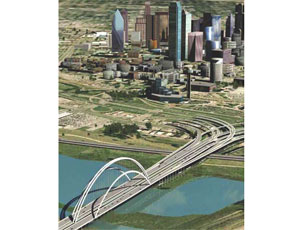The U.S. Army Corps of Engineers recently gave approval for the construction work on the approaches for the Margaret Hunt Hill Bridge to continue. It was a much-anticipated approval and critical step for opening the bridge in 2011, Dallas Mayor Tom Leppert tells Texas Construction.

The Corps provided the approval for the continuation of work after analyzing geotechnical data and analysis conducted for electric utility provider Oncor and the Texas Dept. of Transportation. Corps data indicated that the proposed work will not adversely affect the operation and maintenance of the Dallas floodway and that it provides the required remediation of the levees.
TxDOT and the city of Dallas may proceed with plans to restore the crest height of the levees to their original design elevation under the cross beams of the bridge piers. Part of the Santiago Calatrava designed-Margaret Hunt Hill Bridge features a 400-ft center arch, is a seepage berm for the West Levee; the Corps deemed the plan acceptable as remediation for any slope stability.
On the East Levee, there will be project modifications to address a slope stability issue identified through the geotechnical investigations. The approved plan includes a two-tiered berm to provide reinforcement of the East Levee side slope to minimize the possibility of slope failure.
A seepage collar is being installed at an Oncor tower and seepage collars are also recommended for three existing bridge piers. All repairs will be done by the city’s newly formed Trinity Watershed Management department with a number of the remediation projects already numbered as part of the Trinity River Corridor Project. One such is raising the levees to their original height.
The project’s goal is to “build a significant public project for the city and to provide a new bridge resulting in an improved transportation corridor,” Leppert says.
He adds that [the approval] is “beneficial to the city and surrounding areas.”
Temporary scaffolding is in place across the flood plain in preparation for hoisting the steel box girders that will form the roadway bed of the bridge. The temporary structure is designed to hold the pieces in place as they are fit together. At press time, the first steel was to be raised during the start of the year.
The projected $2.5-billion Trinity River Corridor Project is the largest and most complex public works and urban development project undertaken by the city of Dallas, Leppert says. It is first a flood protection solution and one of the largest of its type in the nation.
The project consists of five major components: flood protection, transportation, recreation, environment management and business development. The expected construction completion is spring 2011.

Post a comment to this article
Report Abusive Comment